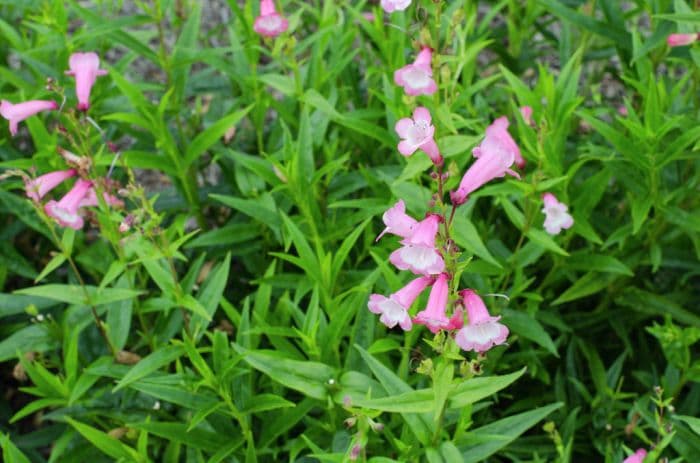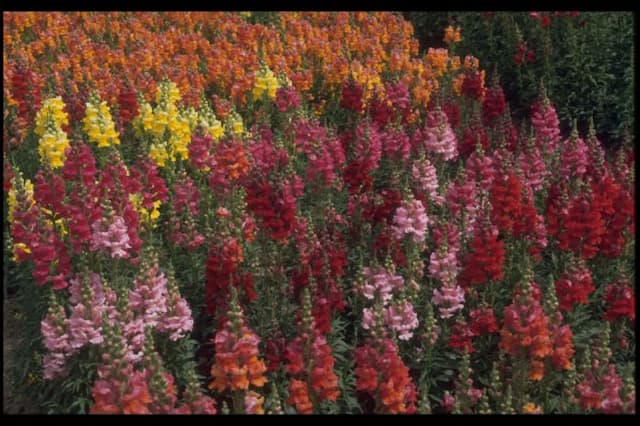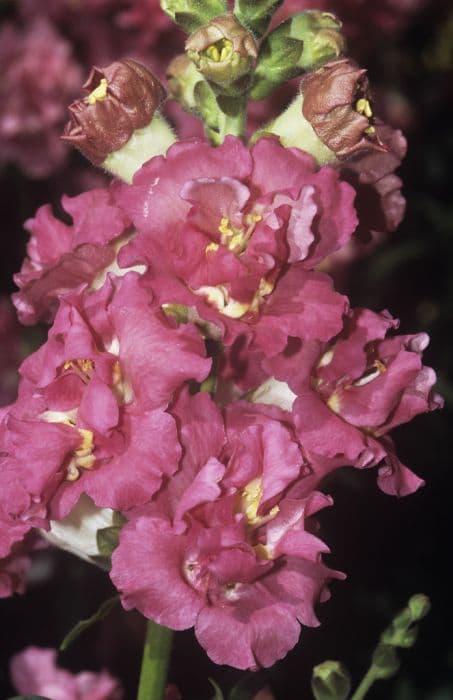Beardtongue Penstemon 'George Elrick'

ABOUT
Penstemon 'George Elrick' is characterized by its striking flowers and foliage. This plant brandishes an appealing contrast with its lush, green leaves that create a vivid backdrop for the flowers. The leaves are lance-shaped, providing a dense and structured greenery. The flowers themselves are tubular and come in a vibrant shade of pink that can grab anyone's attention. They are arranged in clusters on the stems, creating a visually delightful display that seems to almost beckon pollinators from afar. The blooms are known for their white throats that contrast beautifully against the pink petals, often with delicate stripes accentuating the throat of the flower. This combination of features gives Penstemon 'George Elrick' a distinctive and ornamental quality that is highly valued in garden designs and landscaping projects for its aesthetic appeal.
About this plant
 Names
NamesFamily
Plantaginaceae
Synonyms
Beardtongue, George Elrick Penstemon
Common names
Penstemon 'George Elrick'.
 Toxicity
ToxicityTo humans
Penstemon 'George Elrick', commonly known as Beardtongue, is not typically known to be toxic to humans. However, with any plant, individual allergies or sensitivities can occur. If a person is sensitive and ingests part of the Beardtongue plant, they may experience mild gastrointestinal upset or allergic reactions. It is always best to avoid ingesting any part of ornamental plants and to consult medical professionals in case of unexpected reactions.
To pets
Beardtongue, commonly referred to as Penstemon 'George Elrick', is not known to be toxic to pets. It is not listed on common toxic plant databases for animals such as those maintained by the ASPCA. Nonetheless, ingestion of non-food plants can sometimes cause gastrointestinal distress in pets such as vomiting or diarrhea. It is recommended to monitor pets and prevent them from eating ornamental plants, and to consult a veterinarian if they exhibit any signs of illness after ingestion.
 Characteristics
CharacteristicsLife cycle
Perennials
Foliage type
Deciduous
Color of leaves
Green
Flower color
Pink
Height
2 feet 60 centimeters
Spread
2 feet 60 centimeters
Plant type
Herb
Hardiness zones
4
Native area
North America
Benefits
 General Benefits
General Benefits- Attracts Pollinators: Penstemon 'George Elrick' is known for attracting bees, butterflies, and other beneficial insects to the garden, supporting local ecosystems.
- Low Maintenance: This variety of beardtongue is relatively easy to care for and does not require frequent watering or feeding once established.
- Drought Tolerance: Once established, Penstemon 'George Elrick' has good drought tolerance, making it suitable for xeriscaping and dry climate gardens.
- Aesthetic Appeal: With its tubular flowers, often in shades of pink or red, it adds visual interest and color to garden beds and borders.
- Long Blooming Period: Beardtongue typically has a long flowering season, lasting from late spring to early summer, providing extended garden interest.
- Cold Hardy: Penstemon 'George Elrick' can survive in cooler temperatures, making it suitable for planting in a variety of climates, including those with cold winters.
- Versatility: It can be used in perennial borders, rock gardens, and wildflower meadows, providing gardeners with numerous landscaping options.
- Wildlife Habitat: By attracting pollinators, it contributes to creating habitats for various wildlife, enhancing the biodiversity of the area.
- Focal Point: Its upright growth habit and striking flowers make Penstemon 'George Elrick' an excellent focal point in a garden or landscape design.
- Cut Flowers: The blooms make lovely cut flowers for indoor arrangements, bringing the beauty of the garden inside.
 Medical Properties
Medical PropertiesThis plant is not used for medical purposes.
 Air-purifying Qualities
Air-purifying QualitiesThis plant is not specifically known for air purifying qualities.
 Other Uses
Other Uses- Photography Subject: Penstemon's vivid flowers make it a popular choice for garden photographers looking for striking images.
- Edible Flowers: The flowers of some Penstemon species can be used as a colorful garnish in salads or desserts.
- Dye Production: Historically, some species of Penstemon have been used to produce natural dyes for fabric coloring.
- Artistic Inspiration: The beauty of Penstemon flowers often inspires artists and can be found represented in paintings, prints, and textile designs.
- Education and Research: Penstemon species are used in botanical studies to understand plant evolution, pollination mechanisms, and adaptation.
- Craft Projects: Dried Penstemon flowers can be used in craft projects, such as making bookmarks or pressed flower art.
- Nature Crafts: Children can use the branches and flowers for creating natural collages or for learning about plant structures in an educational setting.
- Theme Gardens: Penstemon can be used to create a bee or butterfly-themed garden to attract and support local pollinators.
- Floral Arrangements: Fresh or dried Penstemon flowers can add a unique touch to bouquets and floral decorations for events.
- Culinary Infusions: The flowers can be infused in syrups or vinegars, although it is important to verify the edibility of specific Penstemon varieties before consumption.
Interesting Facts
 Feng Shui
Feng ShuiThe Beardtongue is not used in Feng Shui practice.
 Zodiac Sign Compitability
Zodiac Sign CompitabilityThe Beardtongue is not used in astrology practice.
 Plant Symbolism
Plant Symbolism- Attractiveness - The Penstemon 'George Elrick', often known simply as Beardtongue, boasts vivid and striking flowers that symbolize beauty and the power of attraction.
- Versatility - Beardtongue plants are known for their ability to thrive in various conditions, reflecting adaptability and resilience in life's different circumstances.
- Communicative - With their open, tubular flowers, Beardtongues can be seen as a symbol of open communication and the sharing of thoughts and feelings.
- Healing - In some traditions, certain Penstemon varieties were used medicinally, making the Beardtongue represent healing and therapeutics.
 Water
WaterBeardtongue, including the 'George Elrick' variety, should be watered deeply to encourage root development but allow the soil to dry out between waterings. Typically, this means watering about once a week, with adjustments made for rainfall and temperature. During the growing season, provide about one to one and a half gallons per plant per watering session, depending on the size of the plant and soil conditions. It's crucial to avoid overwatering as Beardtongue is sensitive to water-logged conditions which can lead to root rot. In winter, reduce watering frequency as plant growth and water needs decrease.
 Light
LightFor optimal growth, Beardtongue 'George Elrick' requires full sun to partial shade. This means the plant should receive at least six hours of direct sunlight daily, while still tolerating some afternoon shade. An ideal spot would be a location where morning sun is plentiful but shelter from the intense late afternoon sun is provided, particularly in hotter regions.
 Temperature
TemperatureBeardtongue 'George Elrick' prefers temperate conditions and can generally withstand temperatures down to about 20 degrees Fahrenheit. The ideal growing temperatures range from 60 to 70 degrees Fahrenheit. It's important to protect the plant from extreme cold, as temperatures below 20 degrees Fahrenheit can harm or kill the plant. During hot weather, ensuring adequate watering will help the plant cope with temperatures above 70 degrees Fahrenheit.
 Pruning
PruningPruning Beardtongue 'George Elrick' encourages bushier growth and more blooms. Prune in early spring to remove any dead or damaged stems and to shape the plant. Additionally, deadheading spent flowers throughout the blooming season can promote continued flowering. Typically, little to no pruning is required in the fall, as the plant will naturally die back and can be cut to the ground after frost.
 Cleaning
CleaningAs needed
 Soil
SoilBeardtongue prefers well-draining soil with a pH between 6.0 and 8.0. A mix of loam, sand, and compost is ideal to provide the right balance of drainage and nutrients.
 Repotting
RepottingBeardtongues do not need frequent repotting and can often remain in the same pot for several years unless they outgrow it.
 Humidity & Misting
Humidity & MistingBeardtongue plants are tolerant of average humidity levels and do not require any special humidity conditions for growth.
 Suitable locations
Suitable locationsIndoor
Ensure bright light and good air circulation for growing Beardtongue indoors.
Outdoor
Plant in sun to part-shade; protect from strong winds and heavy frost.
Hardiness zone
5-8 USDA
 Life cycle
Life cycleThe life cycle of Penstemon 'George Elrick', commonly known as Beardtongue, begins with seed germination, typically in the spring when soil temperatures warm up. Seedlings emerge and develop into young plants with a rosette of leaves at the soil level. As the plants mature, they send up flowering stalks, usually in late spring or early summer, where tubular flowers that attract pollinators bloom. After pollination, seeds form in small capsules and are dispersed by wind or animals in late summer or fall. The plants are perennial and overwinter with their evergreen foliage, ready to start the cycle anew the following spring. In colder climates, they may die back to the ground and re-sprout from the crown once the weather warms.
 Propogation
PropogationPropogation time
Spring to Early Summer
Propogation: The Penstemon 'George Elrick', commonly referred to as Beardtongue, is a perennial plant whose most popular method of propagation is through division. The ideal time to carry out this process is in either spring or early fall when the plant is not in active bloom. To propagate by division, you first need to dig up the plant, taking care to keep the root ball intact. Then, using a sharp knife or spade, you can divide the root ball into smaller sections, making sure that each section has at least a couple of healthy shoots and a portion of the root system. These sections can then be replanted in well-draining soil, spaced about 12 to 18 inches apart (which is roughly 30 to 45 centimeters), to give them sufficient room to grow. Water the newly planted divisions thoroughly to help establish them. This method of propagation allows for the Beardtongue to spread and rejuvenate itself, ensuring healthy growth and prolific blooming in the following seasons.





![Snapdragon [Pretty in Pink]](/_next/image?url=https%3A%2F%2Fplants-admin.emdemapps.com%2Fimages%2Fplants%2F%2Fimages%2F604b5cb3b5385.png&w=640&q=75)



